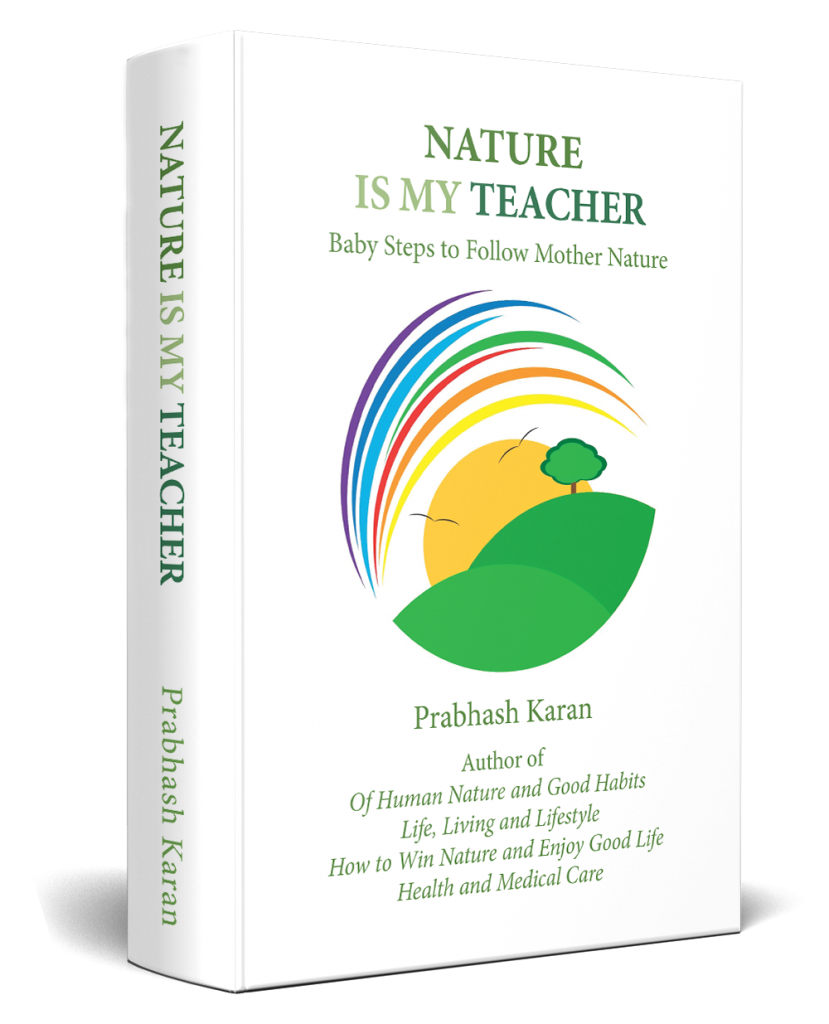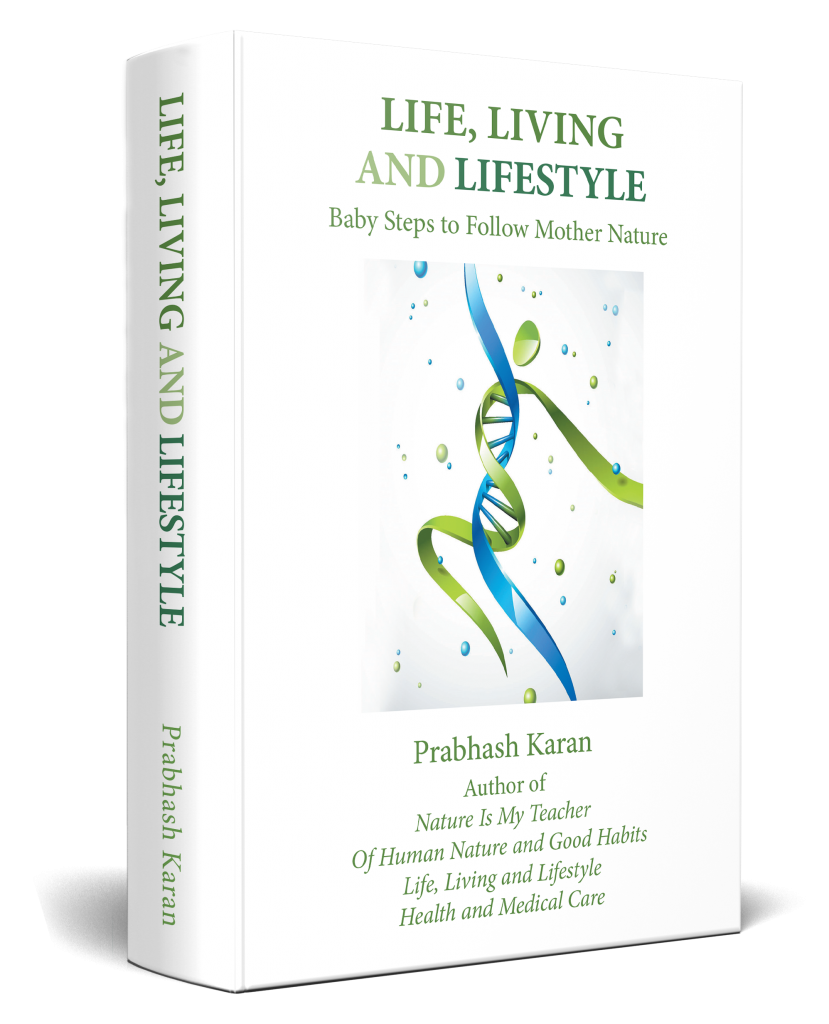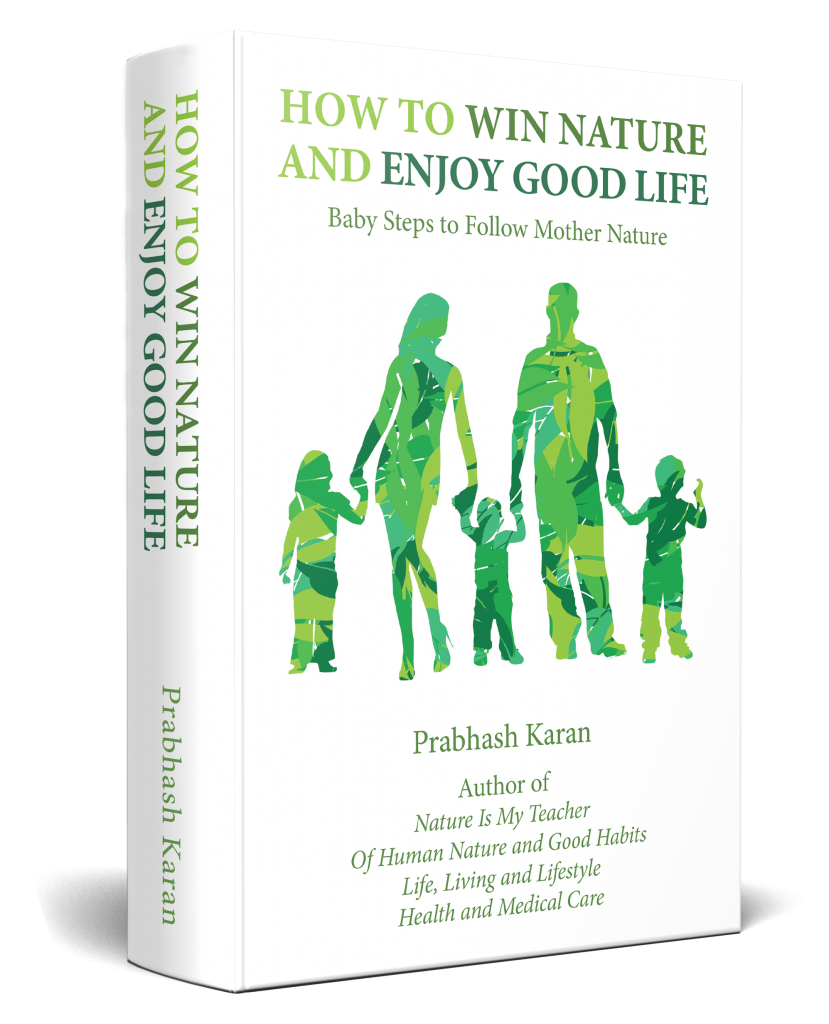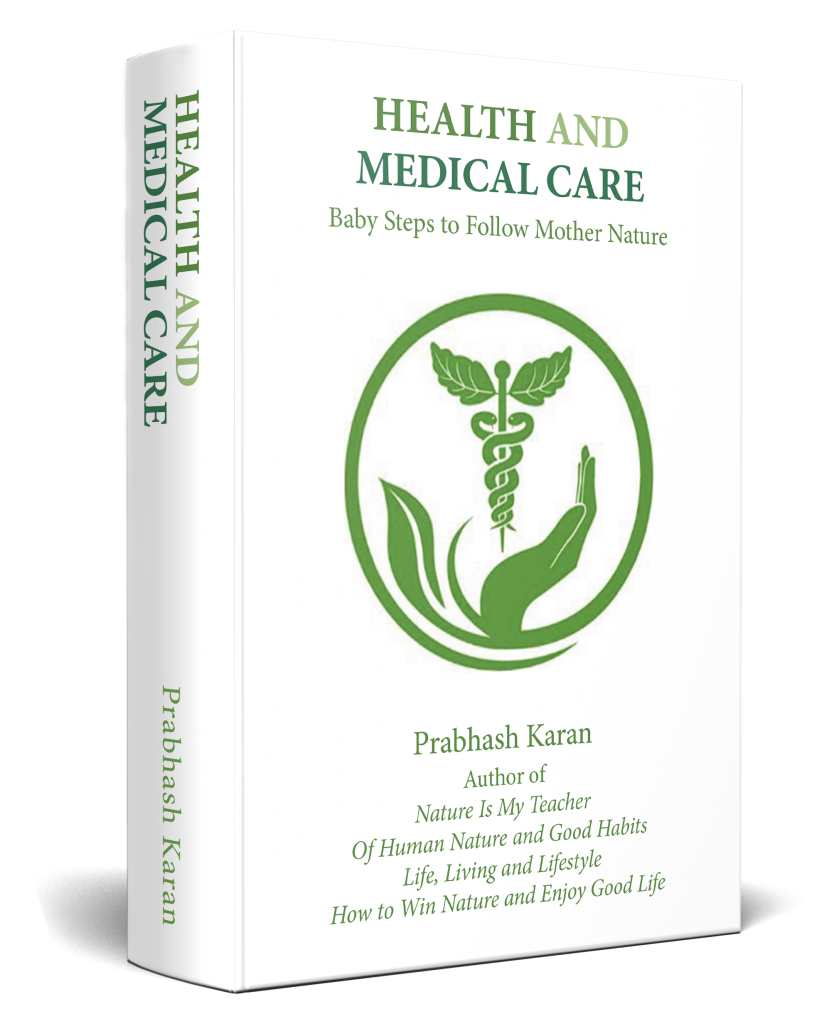
Collection of Books by Prabhash Karan
Five books—Nature Is My Teacher; Of Human Nature and Good Habits; Life, Living and Lifestyle; How to Win Nature and Enjoy Good Life and Health and Medical Care—constitute a series that tells the nature-human connection and its implication in our daily life, in the related set of topics.
Nature Is My Teacher reveals the deep emotional connection between human evolution and civilization! Mother has been and will always remain synonymous with love, devotion, and dedication, and giving nature the attributes of a mother, life-giving and fostering, is simply personification as a nurturing mother.
Read More
The book primarily deals with the physical, notional, and real world in general. The book contains chapters: The Nature (When nature teaches, we learn.); Mother Nature (Mother has been and will always remain synonymous with love, devotion, and dedication. Its personification as a nurturing mother is so primitive.); The Universe (The universe is a source of our profound wonder, awe, and joy.); Planet Earth (Why do the sun and the moon look more of the same size?); The Weather (By weather, we generally mean the state of the atmosphere at a given time and place.); The Air We Breathe (Every human deserves clean air and blue sky.); The Water We Drink (Human civilizations grew, shrunk, or abolished depending on the availability of water.); The Future of Nature (The full melting of Greenland’s ice could raise sea level as much as 20 feet.); Origin of Life (What sparked life on earth?); Gift of Life (Life is the best gift to the fortunate few who got it.); Human Life (Human development is not only impossibly complex, but it is also a just marvelous.); Human Evolution (Human Evolution by natural selection is now being switched to evolution by human intervention.); Self and the Rest of the World (I am here because of you!); Time Goes By (Time is a very precious thing.); Life Changes Over Time (Humans are socially elastic and adaptive.); Worries, Anxieties, Fear, and Regret (We suffer from worrying well before worry starts or never starts.); How to Deal with Stress (The contemporary idea of stress is a very recent phenomenon.); Depression (Please stop merchandising mental illness!); Kindness and Devotion (Among all our base instincts, hate is one distinctly human. In animals, strength, violence, and venom are the weapons of survival, but in humans, their supremacy.); Charity and Humanity (Cheese in the mousetrap is not a charity.); The Power of Hope (Hope is a wonderful trick that Mother Nature has planted in the human mind that counterbalances our grief, sorrow, fear, dread, and regret. Hope is not a strategy, yet it is. During the time of war, hope is the weapon.); Education and Experience (We are not born knowledgeable. We gather knowledge primarily through education. Education is not a privilege; it is a civil right, precisely, a human right that refers to the “basic rights and freedoms to which all humans are entitled.”)
In the human body, there’s always exists—a human inside! The book, Of Human Nature and Good Habits, reveals that human inside and helps you to develop and promote good personal habits and social skills.
Read More
The book primarily deals with our everyday experiences of good life and living. The book contains chapters: Human Nature (By nature, all humans are alike, but practice sets them apart.); Nature vs. Nurture (One-third born (nature) and two-thirds made (nurture)! It is a huge statement.); Personality (Don’t let others evaluate you. Do not imitate others; do not impersonate others.); Patience and Confidence (Our ability grows or shrinks in proportion with our courage.); Discipline and Good Habits (Children are raw and wild by nature. They need to be disciplined.); Courage, Attitude, and Ambition (Do what you think best; otherwise, you will do what others think best.); Aim in Life (Everyone plans to succeed; no one plans to fail. But failure happens. Failure is one essential part of success; but the fear of failure is the killer of success.); Mind and Mental Habits (Genius and genuinely creative people have two things in abundance: curiosity and drive.); Mind and Body (Human brain—weighing about 3 pounds, accounting 2% of the body’s weight—is a biological machine that consumes 20% of the body’s energy production.); Mind and Memory (Speaking multiple languages may help protect cognitive health over the long term, and may delay Alzheimer’s disease.); Power of Meditation (It is not figuring out what is wrong with you and trying to fix it; rather, it is identifying what is right with you and trying to do more of it.); Greed, Envy, and Jealousy (During the evolutionary process, individuals with strong innate yearnings for food, sex, and material gain, have a better chance of surviving and reproducing than other individuals with less yearning.); Humor and Laughter (Laughter is one universal emotion!); Talk and Sing (Talk is the publication of thoughts! It is the momentum of our mind! Music is a special announcement how one’s feel of feelings is expressed in the form of sound.); Nature and Natural Habits (Man invents a mousetrap, but nature plays a better mouse.); Be Wise (Be aware of data aggression. Overloaded memory can extinguish our natural spirit. Don’t ingest anything that you can’t digest.); Be Happy (Count carefully what makes you worthwhile and happy, and discount wisely what makes you worthless and unhappy.); Be Honest, Simple, and Natural (Honesty is the state of mind; dishonesty is not. Therefore, it’s wise to encourage honesty rather than discourage dishonesty.)
A life is what is given to us; a lifestyle is what is given by us. Research claims that maintaining only 5 good habits—(1) eating a healthy diet, (2) exercising regularly, (3) drinking only in moderation, (4) not smoking and (5) maintaining a healthy body weight—can not only keep the life vibrant through years but also extend a woman’s life expectancy at age 50 by 14 years, and a man’s by 12 years. The book illustrates these aspects of lifestyles with a special connection between human evolution and civilization!
Read More
The book contains chapters: Active Lifestyle (As we grow, we travel through a series of institutional communities: first our family, then our educational institutions, then our workplace, and then our local and global institutions.); Play and Exercise (The guidelines of World Health Organization (WHO) on physical activity for an adult is very attainable: 75 minutes of vigorous exercise or 150 minutes of moderate exercise per week.); Joy of Yoga (“I lost weight,” “I quit smoking,” It de-stressed me, I sleep better, It saved my marriage, It improved my child’s grades, I am now pregnant, It saved my family—on and on and on, goes the claims of yoga’s practitioners.); Lose Weight (As definition in the centimeter-gram-second (CGS) system, the BMI number is a person’s weight in kilograms (kg) divided by square of height in meters (m). BMI=kg/m^2.); Walking and Running (An adult can walk 17,000 steps a day comfortably, which is roughly 7 to 8 miles.); Quit Smoking (The truth of smoking is disease, death, and horror—not glory, glamour, or pleasure.); Sleep (Sleep is by far the single critical factor, and definitely a calmest booster to improve the brain function.); Life, Living and Work Ethics (Simple life has its own reward.); Science and Technology (The tiny computer chips are embedded in all our gadgets, devices, and machines, from cell phone to brain cell, from microscope to telescope, and from subatomic level to space-level equipment.); Organize Yourself (For organizational skill, discipline is at the root.); Work and Workplace (In a global job war, according to a Gallup poll in 2011, out of 7 billion people worldwide, there were 5 billion people over fifteen years old, out of which 3 billion wanted full-time jobs, while there were available only 1.2 billion jobs.); Personal Finance and Money Habits (Poverty is not a shame, but being ashamed of it, is. Young minds are systematically victimized. When they grow up, they feel the guilt and shame of poverty.)
Love wins, hate ruins. Human, by nature, loves more readily than hates occasionally. The book explores innate human traits and its relationship with nature.
Read More
The book primarily deals with love, relationship, marriage and family life. It contains chapters: Love and Relationships (Love is hard to describe; it is often mystifying and unknowable. You may never know even in your lifetime. But you can’t miss to sense it.); Marriage (To be a woman, childlessness is a private sorrow. Childlessness signifies a rolling loss into the future. It means no children, no grandchildren.); Family (Today, children suffer from the lack of love and care, affection and attention from their parents on a daily basis.); Children (Children are the most valuable resources of this planet—one-third of our present population and all of our next generations. If you want to give one gift to your child, then let it be enthusiasm.); Friends and Society (Most Americans are home alone (2.6 people per household), drive alone (1.6 per car), and stay alone.); Life Is Good (Research on well-being basically concentrates on three core factors: (1) health, (2) relationships, and (3) a sense of purpose.); Life is Beautiful (Life is half spent before we envision what life is. We are sorry for the past and worry for the future. But true living never has to be all regrets of the past or all prospects of the future.); Live Young, Live Long (Globally, life expectancy grows and shrinks according to income trends.); Enjoy Good Food (Food is remarkably a bonding force. Survey finds that in more than a quarter of families, food is considered to be an emotional response and a meaningful way to show affection.); How Food Works (Breakfast jump-starts the metabolism process of the day. So, don’t skip or mess it up. People who do not break fast soon after rising (half an hour or so), or take breakfast later in the morning, typically consume more calories over the course of the day and run a higher risk of type 2 diabetes and obesity.) Diet and Nutrition (Humans evolved to eat. Anthropologists looked at the diets, habits and physical activities of hundreds of modern hunter-gatherer groups and small-scale societies, whose lifestyles are very similar to those of ancient populations, and find that they all generally exhibit excellent metabolic health while consuming a wide range of diets.); Herbs and Spices (The herb is always of plant origin. It is not of animal origin; nor is it a supplement that was developed in a lab.)
The sweetness of wellness is better realized through the bitterness of illness. The book dispenses the first-aid care and preventive measure in many of our common illness.
Read More
The book deals with health and medical care services, and primarily, aids to prevent diseases and stay healthy and thrive. The book contains chapters: Men’s Health (Recent findings suggest that men’s shorter life span is not due to genetic reasons only; it has partly to do with their behavior, lifestyle, and living conditions.); Women’s Health (Although in medical terms, it does not deem that the developing embryo or fetus is as a child, an expecting mother is so attached to the pregnancy so early on that when the miscarriage happens, the woman loses not just a pregnancy but a child of her own—the very dream of her motherhood. Someone she loved, was never born!); Children’s Health (Research indicates that 22% of babies who were exposed to antibiotics before 6 months of age have an increased likelihood of being overweight by age 3, compared with unexposed infants.); Medical Care (The health care will represent 20% of the total economy in 2025.); Human Organs (The eye is the extension of the brain. It is the most sensitive part of our central nervous system (that connect to the brain). Over 80% of our learning (and perception) is mediated through our eyes.); Blood Pressure (Most physicians consider a blood pressure of 120/80 as ideal.); Heart Attack and Stroke (To protect from cardiovascular illness, please do: (1) exercise, (2) eat healthy, (3) lower your B.P., (4) lower your cholesterol, (5) control your blood sugar, (6) maintain a healthy weight, and (7) don’t smoke.); Diabetics (Type 1 diabetes is a lifelong chronic condition where the pancreas produces little or no insulin. Type 2 diabetes is also a lifelong chronic condition where the pancreas produces the insulin, but the body is partially or completely incapable of using that insulin, or the cells ignore the insulin altogether.); The Cancer (Cancer is not just one disease but a set of allied diseases in which a group of cells (a) demonstrate uncontrolled growth and divide beyond the normal limits; (b) invade adjacent tissues; and sometimes (c) metastasize, which is very dangerous because it involves an interaction between rogue cells and healthy cells.); Old Age and Death (The inevitability of death infuses us with a meaning and an urgency. Let Mother Nature give you the last kiss of life. You leave the earth dramatically alone and absolutely by yourself.)
![]()




